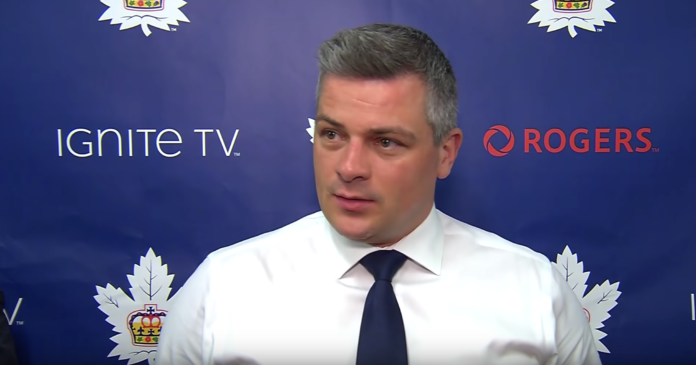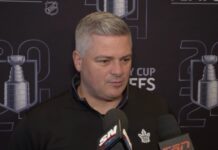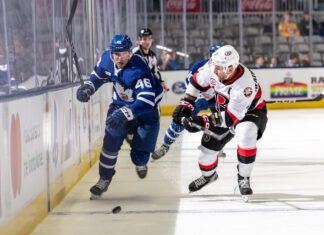
Toronto Marlies head coach Sheldon Keefe joined Leafs Lunch on Thursday afternoon, discussing the Marlies’ 8-2-2-1 start, Rasmus Sandin’s development objectives, and the systems synergy between the Marlies and Leafs.
The Toronto Marlies are sitting second in the North Division with an 8-2-2-1 record. In sports, we always say, “What is the identity of your team?” What would you say the identity of the Marlies is right now and why this team continues to be so successful?
Keefe: The first thing I would say is that the success is sort of relative. We’ve found ways to get positive results. We started the season with the best start in franchise history in terms of the record out of the gates. It hasn’t gone as well of late. Even when we were winning earlier in the season consistently on that franchise-record start, we didn’t really like how we were playing. We thought we were capable of playing a lot better and frankly, we were relying on our goaltenders and some really positive results on special teams that were really carrying us through.
We want to be a team that can play a lot better more consistently. One of the areas we think is our identity here with the Marlies is just to play a really efficient game with and without the puck, and try to keep the puck when we have it and make plays and be intelligent and purposeful with it. When we don’t have it, be aggressively working to get it back. That has taken some time to come together the way we’d like it to.
We’ve battled a lot of injuries and had a lot of new faces here as well that have created some challenges for us. Fortunately for us, we’ve been able to get some positive results and keep our heads above water. We are looking forward to continuing to work and finally getting back on home ice. It’s now been three weeks since we’ve been in the Coca Cola Colesium even for practice. It has been tough that way, but we are looking forward to getting back on home ice this week.
You’ve got new players coming in like Kenny Agostino, Pontus Aberg, and Jordan Schmaltz — players that are experienced. The younger players are learning, too, but how long does it take for them to grasp what you are trying to do and say, “This is something we really can sink our teeth into”?
Keefe: I think it is player specific, right? Every player is going to be different in terms of how they grasp it. I think in particular with our defense, we ask them to do a lot of things with and without the puck that for many of them, they’re hearing for the first time. It is a lot different than how they are being asked to play in different places. For some of them, it is a challenge and it takes time. We believe once they get it, things really start to come together for both them and our team.
Looking at our defense, we have Sandin and Liljegren here that spent significant time with us last season. Beyond that, we have six new other guys making up our eight defensemen. It has been a challenge in that sense, but it is exciting at the same time because you get to teach these concepts and try to make the players be Marlies and play the way we want to play and the way we’ve built the program up over the last number of years. That is a fun process for me and our staff.
Back to the process — as they are trying to grasp it, what are some of the things that you try to emphasize with the players if they’re trying to grasp it and they’re not quite there? What do you emphasize for these guys to keep the conviction that this is going to pay dividends?
Keefe: The communication is a big part of it both in terms of how we communicate with our team as a whole and then perhaps more importantly, to the individuals. It’s just continuing to reinforce through the use of video the positive signs we are seeing and the steps we are seeing. We are also showing the finished result with some of our previous players or some of the clips within our game. Within a 60-minute hockey game, you can pick out a lot of things that you don’t like, but there are so many things happening in a game that there are always going to be a number of things that are excellent. You want to highlight those as much as you can and continue to work towards it, and make sure what we are doing in practice is reinforcing what we want to see.
I think that is all we can do as well as having the patience to stick with it every single day. We have been fortunate to get results. That has been good. If you look at our division this season, it is looking like it is going to be extremely competitive and despite having such a great start, we are very much in a battle and it doesn’t seem like it is going to change much throughout the season.
How much of the systems do you share between the Marlies and Leafs? How much do they expect the Marlies to experiment with new systems? What were you told to work on with Rasmus Sandin when he was sent back to the Marlies?
Keefe: The process really hasn’t changed a whole lot in terms of my relationship with the Leafs and with Mike Babcock and the Leafs staff. I take part in all of their meetings in the summertime and I’m with them all through camp and exhibition season. I am just fortunate enough to be a part of that staff throughout the entire process. Most of the players that are with us now are also in that mix. Learning the system and the structure — that part of it doesn’t change when they come here, obviously.
We are trying to build players to play for the Maple Leafs, so how we are playing defensively and the structure that we play with and the expectation of what they want here is something we work towards every single day. We are constantly pulling clips from Leafs games and showings them to players what they are expected to know and what it looks like at the NHL level. We are reinforcing that daily.
Within that, we believe given we are more in a development level, we are also trying to try different things and push players beyond a certain structure and a certain system — trying to create really complete players and work on different skills that may be more advanced beyond what is expected so that when the opportunities are there, they can take advantage of them. But certainly knowing the structure and knowing the spots to be in is priority one, and that’s established very well by Mike and the Leafs training camp by day one of training camp.
On Sandin, is there anything, in particular, to work on with him?
Keefe: With Sandin, we sat down with Mike and Rasmus and went through a lot of clips and talked about what they saw at that level that they wanted him to work at here. His defensive play was certainly a big part of it — sorting things out in the defensive zone and boxing out and keeping players away from the net was a big part of it, and knowing when to move the puck quick and getting it into the forwards’ hands, and playing quickly in transition. Those types of things were the focus and have been the focus.
It’s a lot different for him here, where he’s playing upwards of 30 minutes the other night. It is consistently 25 minutes or above for us and he’s taken on a lot in terms of first-unit power play, first over the boards on the penalty kill, playing against the other teams’ best players. It is a great challenge for him and one we believe and the organization believes he’ll be able to do in the NHL one day. We are working towards that here now. It is a process of him improving upon those defensive pieces and continuing to get stronger and taking advantage of the extra time in the gym the American Hockey League allows for. It is a process, but there are a lot of things to be excited about with him.



![Sheldon Keefe Post Game, Leafs 3 vs. Bruins 2: “I loved [the Matthews] line, and I loved a lot about our game all the way through the lineup” Sheldon Keefe, Toronto Maple Leafs post game](https://mapleleafshotstove.com/wp-content/uploads/2024/04/keefe-pg-game-1-218x150.jpg)

























![Sheldon Keefe Post Game, Leafs 3 vs. Bruins 2: “I loved [the Matthews] line, and I loved a lot about our game all the way through the lineup” Sheldon Keefe, Toronto Maple Leafs post game](https://mapleleafshotstove.com/wp-content/uploads/2024/04/keefe-pg-game-1-100x70.jpg)




![Jim Montgomery on adjustments for Game 2 vs. the Maple Leafs: “We need to spend more time in the offensive zone… We didn’t do a good job offensively at five-on-five [in Game 1]” Jim Montgomery, Boston Bruins practice](https://mapleleafshotstove.com/wp-content/uploads/2024/04/jim-montgomery-bruins-100x70.jpg)